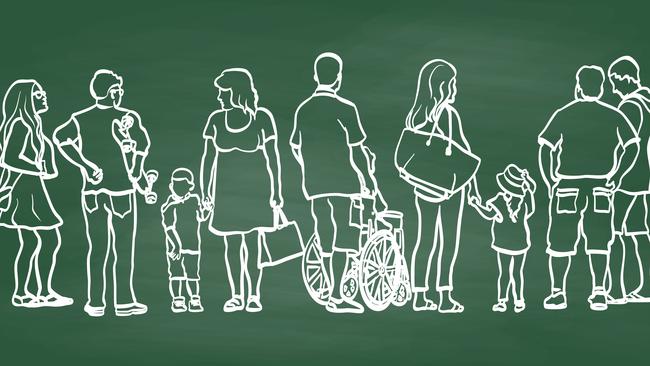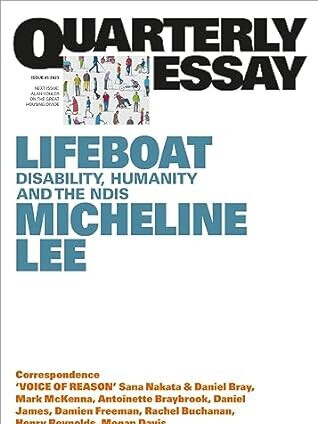The hope v the reality of the NDIS
People ‘treat disability like it’s a kind of strange and unnatural occurrence’, according to a new book. But, as NDIS numbers show, function and limitation are spectrums and ultimately dependent on both fate and funding.

When former PM Julia Gillard introduced the bill that founded the National Disability Insurance Scheme, it kicked off Australia’s most significant social reform in a generation. The government said the scheme would “transform the lives of people with disability, their families and carers. For the first time they will have their needs met in a way that truly supports them to live with choice and dignity.”
Those who are disabled and those who care for and love them – parents in particular, whose trials and tribulations can defeat belief - do not want dependence on what artist and lawyer Micheline Lee refers to in Lifeboat: Disability, Humanity and the NDIS as the “budgetary priorities of the government of the day”; care has to be a right, not charity.
The concepts of choice and dignity involve measures such as community assistance, disability-related therapy, domestic help, home access modifications, personal care, and so on, to facilitate the self-management that makes equality - and the resulting emotional equilibrium - possible.
Support of this nature not only benefits the 20 or so per cent of Australians with disabilities, but all Australians “by providing them the assurance that if they were to acquire a disability, they would be supported for the rest of their life, and by helping create a more inclusive society.”
This is, of course, easier in theory than practice.
The bureaucracy alone can be stifling. Certain service providers refuse to work after 9.30pm, meaning that the person requiring care can never go out at night. Others refuse to help with children as they are limited to the performance of personal care duties. Months pass as people wait for requests to bounce from department to department. After a friend, out of desperation, suicided, Lee discovered that the red tape by which the NDIS is defined can also cost lives.
“Disabled people wanted more than just survival, getting out of bed, showering and eating, and maintaining basic health,” she writes. “They wanted support.”
So how can human rights goals become effective policies and practical realities? A pragmatist to the bone, Lee notes that the previously underfunded disability support system needed an extra $6.5 billion pa minimum to achieve advocated goals, but in order to attract bipartisan support, economic justification was required. In 2011, the Australian Productivity Commission provided it: NDIS benefits – “in the form of increased employment of people with disabilities” – would, by 2050, not only outweigh costs but add close to one per cent to our GDP.
Lee, however, does more than cite numbers or empathise with the disenfranchised; she has skin in the game. One of five Malaysian-born siblings, she was, along with the two youngest, born with Spinal Muscular Atrophy, and like them, remains wheelchair-bound. Her father “believed the three of us were the result of an ancestral curse … he would tell us the story of how his mother had been obliged by custom to live in the home of her husband’s ageing parents and care for them. But she broke her duty and talked her husband into leaving his parents’ home.” On the day they walked out, her grandfather’s parents slaughtered a pig and cursed them.

Migrating to Australia at the age of eleven, Lee was further disorientated by her parents’ conversion to Christianity. Repeatedly, she and her siblings had hands laid upon them in prayer. “Demon of sickness, in the name of Jesus, leave the bodies of these children!” the evangelists shouted. Terrified by her vulnerability, Lee became a lawyer. There was, she writes, “no place for weakness in some of my legal jobs, and I would get pressure sores from sitting too long in one position rather than show that I needed help. But my body could not be controlled. My motor neurons continued to die, my muscles wasted, and I got weaker.”
For Lee, the future was a landscape of terror. What would become of her when she grew too weak to care for herself? Would anyone help care for her? Would anyone care at all? Overriding all other considerations, a question: “Will there be a place for me in this world?”
Impossibly moving and important, Lifeboat: Disability, Humanity and the NDIS not only makes clear why, as a community, we have to rally to the needs of the most vulnerable, but unlocks a universe otherwise invisible to the able-bodied – one in which the wheelchair-bound develop kidney stones after regularly dehydrating themselves before going out as there are so few accessible public toilets; in which airport staff refuse to offer the most basic assistance in the absence of a carer “because it’s not their job”; and in which a mother, in desperation after having her calls blocked because officials refused to accept that her paralysed daughter needed a wheelchair, had to threaten to leave the child with the planner if they continued refusing help.
As Lee reminds us, disablement can strike any of us at any time – tripping on an uneven pavement, a fall from a low balcony, a slip in the bathroom - transforming the most ordinary life into a series of increasingly demoralising battles for basic survival. People, she writes, “treat disability like it’s a kind of strange and unnatural occurrence.” But, as NDIS numbers show, function and limitation are spectrums and ultimately dependent on both fate and funding.
Antonella Gambotto-Burke’s new book is Apple: Sex, Drugs, Motherhood and the Recovery of the Feminine. Follow her on Instagram.
Lifeboat: Disability, Humanity and the NDIS (Quarterly Essay)
By Micheline Lee
Black Inc.
200pp, $27.99



To join the conversation, please log in. Don't have an account? Register
Join the conversation, you are commenting as Logout